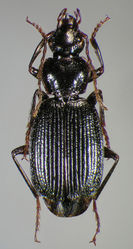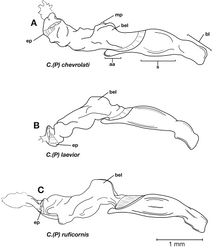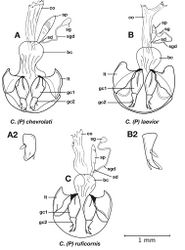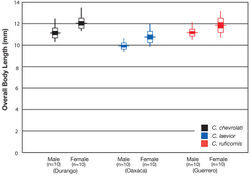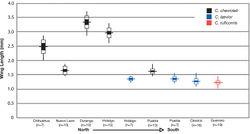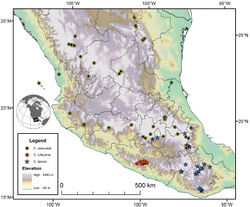Cymindis ruficornis
| Notice: | This page is derived from the original publication listed below, whose author(s) should always be credited. Further contributors may edit and improve the content of this page and, consequently, need to be credited as well (see page history). Any assessment of factual correctness requires a careful review of the original article as well as of subsequent contributions.
If you are uncertain whether your planned contribution is correct or not, we suggest that you use the associated discussion page instead of editing the page directly. This page should be cited as follows (rationale):
Citation formats to copy and paste
BibTeX: @article{Hunting2013ZooKeys259, RIS/ Endnote: TY - JOUR Wikipedia/ Citizendium: <ref name="Hunting2013ZooKeys259">{{Citation See also the citation download page at the journal. |
Ordo: Coleoptera
Familia: Carabidae
Genus: Cymindis
Name
Cymindis ruficornis (Bates) stat. n. – Wikispecies link – Pensoft Profile
- Pinacodera atrata var. ruficornis Bates 1891[1]:270. TYPE MATERIAL: 30 specimens. LECTOTYPE: female, here selected, labeled: “Type/ HT” [circular, ringed with red]”; “Omilteme/ Guerrero/ July H.H. Smith”; “Tr. Ent. S. L., 1891/ Pinacodera atrata Chevr./v. ruficornis, Bates”; “1891-64”; Pinacodera/ atrata var./ ruficornis [handwritten] [BMNH]. TYPE LOCALITY: Omiteme, Guerrero, Mexico.
Diagnosis
Adults of Cymindis ruficornis (Fig. 33) are distinguished from those of the other species of the chevrolati complex by erect pilose setae covering the entire dorsal surface, one to three long setae on the each lateral pronotal margin, in addition to the typical fixed setae, and their restricted geographical distribution (Fig. 41).
Description
With character states of subgenus Pinacodera restricted as follows: OBL 10.50 – 13.17 mm. Length (n= 10 males, 10 females): head 0.92 – 1.20, pronotum 2.04 – 2.60, elytra 5.42 – 7.17, metepisternum 1.08 – 1.20 mm; width: head 1.96 – 2.56, pronotum 2.76 – 3.56, elytra 4.17 – 5.42, metepisternum 0.70 – 0.84 mm.
Body proportions. HW/HL 2.03 – 2.33; PWM/PL 1.31 – 1.41; EL/EW 1.18 – 1.37; ML/MW 1.35 – 1.45. Color (Fig. 33). Dorsum of head and pronotum piceous; head typically rufo-piceous from hind margin of eyes forward; legs piceous to rufo- piceous; epipleuron and abdominal sterna rufo-piceous to piceous.
Microsculpture. Elytra with mesh pattern isodiametric, microlines shallow in most specimens, in few specimens more so in basal third.
Macrosculpture and pilosity. Dorsal punctures with setae present, erect and easily visible at low magnification. Ventral surface of head with evenly scattered setigerous punctures (bearing somewhat long pilose setae) from behind eye laterally toward mentum. Pronotum with evenly scattered punctures and pilose setae over entire dorsal surface. Elytral epipleuron with scattered punctures and pilose setae, setae longer and more regular in apical half.
Fixed setae. Pronotum with two to five fixed setae along lateral margin; elytra with two setae in stria 3 and 16 to 18 umbilical setae; two setae on each of abdominal sterna III to VI; four to eight setae along apical margin of sternum VII, typically six.
Luster. Elytra glossy.
Hind wings. Markedly reduced. Length 1.09–1.49 mm, mean 1.28 mm.
Male genitalia. Phallus (Fig. 34C) length 2.42 – 2.56 mm.
Female genitalia. Gonocoxite 2 (gc2) (Fig. 35C) long and narrow.
Collection notes and habitat
The known elevational range of Cymindis ruficornis extends from 1980 to 2774 m. Specimens have been collected in leaf litter and under wood and stones in forests of oak, pine, fir, and alder.
Geographical distribution
The known range of this species is restricted to the easternmost portion of the Sierra de Atoyac, in eastern Guerrero (Fig. 41).
Morphological affinities
Based on genitalic characteristics and wing length states (Fig. 40), I postulate that Cymindis ruficornis is the closest relative of Cymindis laevior.
Chorological affinities
Cymindis ruficornis is allopatric in relation to the other members of the chevrolati complex and all other members of the limbata species group.
Material examined
I have examined 116 specimens; 10 males and 10 females were dissected. For details see University of Alberta Strickland Virtual Entomology Museum Database (University of Alberta 2009[2]).
Taxon Treatment
- Hunting, W; 2013: A taxonomic revision of the Cymindis (Pinacodera) limbata species group (Coleoptera, Carabidae, Lebiini), including description of a new species from Florida, U.S.A. ZooKeys, 259: 1-73. doi
Other References
- ↑ Bates H (1891) Additions to the carabideous fauna of Mexico, with remarks on some of the species already recorded. Transactions of the Entomological Society of London 1891, 223–278, illus.
- ↑ University of Alberta (2009) E. H. Strickland Virtual Entomology museum Database. Retrieved August 25, 2009, Web site: http://www.entomology.museums.ualberta.ca/
Images
|
